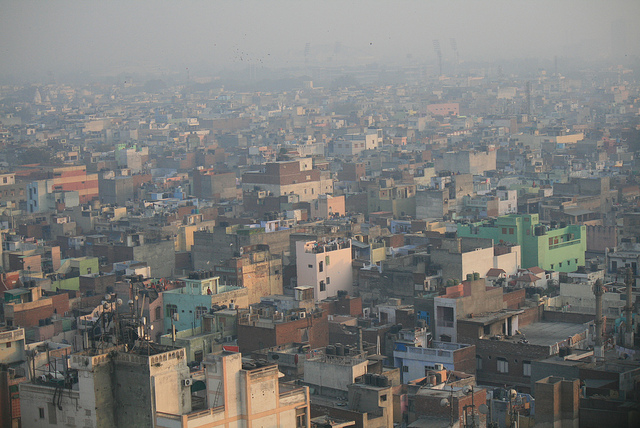全世界各地區都有空氣污染問題,但是低收入城市往往受創最嚴重。世界衛生組織(WHO)12日發表報告指出,全球有超過80%的人口住在污染程度超標的都市,而只有乾淨運輸、效率發電和妥善的廢棄物管理,才能讓全世界最貧窮的城市減緩空氣污染。
印度德里的空氣污染,在世界各大城市榜上有名。圖片來源:jepoirrier(CC BY-SA 2.0)。
中低收入國家人口超過10萬人的城市,有98%空氣品質未達WHO標準,高收入國家僅56%。未達標準城市的污染程度,要比WHO發佈的標準還高出10倍。
WHO都市空氣污染資料庫涵蓋103個國家共3000個人口聚集區,這些聚集區規模小至100人,大至900萬人。大多數資料來自人口超過5萬人的城市。約25%的資料來自2萬人以下的城市。
過去兩年,越來越多城市意識到空污對健康的影響,開始測量空污程度,讓WHO資料庫成長近一倍。
由空氣中大小懸浮微粒形成的污染,是影響健康最鉅的環境風險,每年造成全世界300萬人過早死亡。隨著都市空氣品質惡化,居民罹患中風、心血管疾病、肺癌和氣喘等急慢性呼吸道疾病的風險越高。
WHO比較2008至2013年間,67國795個城市的大小懸浮微粒(PM2.5和PM10)濃度。PM10和PM2.5包括硫酸鹽、硝酸鹽和黑碳,能進入肺臟深處和心血管系統,損害人體健康。
大部分都市空氣污染源非個人所能控制,需要城市政府的行動,以及國家和國際政策制定者推廣乾淨運輸、效率發電和廢棄物管理。
淨化都市空氣並非不可能。高收入國家超過半數的城市,中低收入國家1/3的城市,五年內減緩空污程度超過5%。最可行且付得起的辦法包括減少工業煙囪排放、增加太陽能和風力等乾淨能源的使用、推廣都市大眾運輸、步行和單車網。
WHO的博士多拉(Carlos Dora)表示:「城市和國家政府必須將空氣品質視為健康與開發重點。空氣品質改善,相關醫療成本就降低,工作者生產力提高,壽命延長。此外還帶來氣候效益,幫助國家實踐氣候承諾。」
5月24至30的世界衛生大會,會員國將討論如何因應空氣污染對健康的影響。
Only cleaner transport, more efficient energy production and improved waste management can move the world’s poorest cities to reduce their air pollution – currently up to 10 times higher than levels approved by the World Health Organization, the world’s top health agency said in a new report released today.
More than 80 percent of the people living in urban areas that monitor air pollution are exposed to air quality levels that exceed the World Health Organization (WHO) limits, the UN’s health agency said in a new report today.
All regions of the world are affected, but populations in low-income cities suffer the worst effects.
Some 98 percent of cities in low- and middle income countries with more than 100,000 inhabitants do not meet WHO air quality guidelines.
In high-income countries, that percentage decreases to 56 percent.
The WHO urban air quality database covers 3,000 human settlements in 103 countries ranging in size from a few 100 to more than nine million inhabitants. Most of the data comes from cities with populations of 50, 000 inhabitants or more. Roughly 25 percent of the data comes from smaller urban areas of up to 20,000 residents.
In the past two years, the database has nearly doubled, with more cities measuring air pollution levels and recognizing the associated health impacts.
Ambient air pollution, made of high concentrations of small and fine particulate matter, is the greatest environmental risk to health, causing more than three million premature deaths worldwide every year.
As urban air quality grows worse, the risk of stroke, heart disease, lung cancer, and chronic and acute respiratory diseases, including asthma, increases for the people who live in these cities.
WHO compared a total of 795 cities in 67 countries for levels of small and fine particulate matter (PM10 and PM2.5) during the five-year period, 2008-2013.
PM10 and PM2.5 include pollutants such as sulfate, nitrates and black carbon, which penetrate deep into the lungs and into the cardiovascular system, posing the greatest risks to human health.
Most sources of urban outdoor air pollution are beyond the control of individuals and demand action by cities, as well as national and international policymakers to promote cleaner transport, more efficient energy production and waste management.
But it is possible for cities to clear the air. More than half of the monitored cities in high-income countries and more than one-third in low- and middle-income countries reduced their air pollution levels by more than five percent in five years.
Reducing industrial smokestack emissions, increasing use of renewable power sources, like solar and wind, and prioritizing rapid transit, walking and cycling networks in cities are among the suite of available and affordable strategies.
“It is crucial for city and national governments to make urban air quality a health and development priority,” says WHO’s Dr. Carlos Dora. “When air quality improves, health costs from air pollution-related diseases shrink, worker productivity expands and life expectancy grows. Reducing air pollution also brings an added climate bonus, which can become a part of countries’ commitments to the climate treaty.”
During the World Health Assembly, May 24-30, Member States will discuss how to counter the adverse health effects of air pollution.
※ 全文及圖片詳見:ENS






